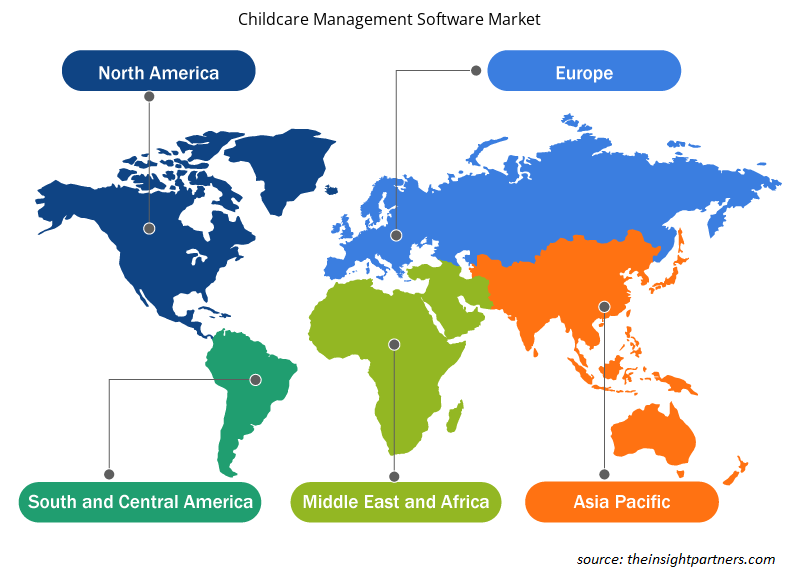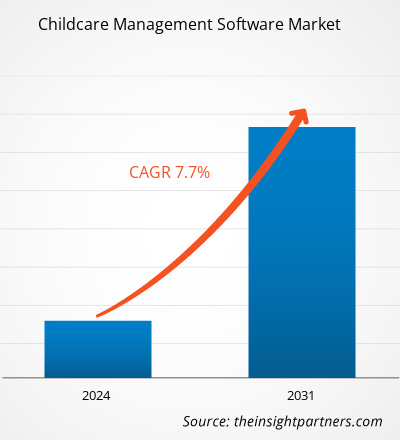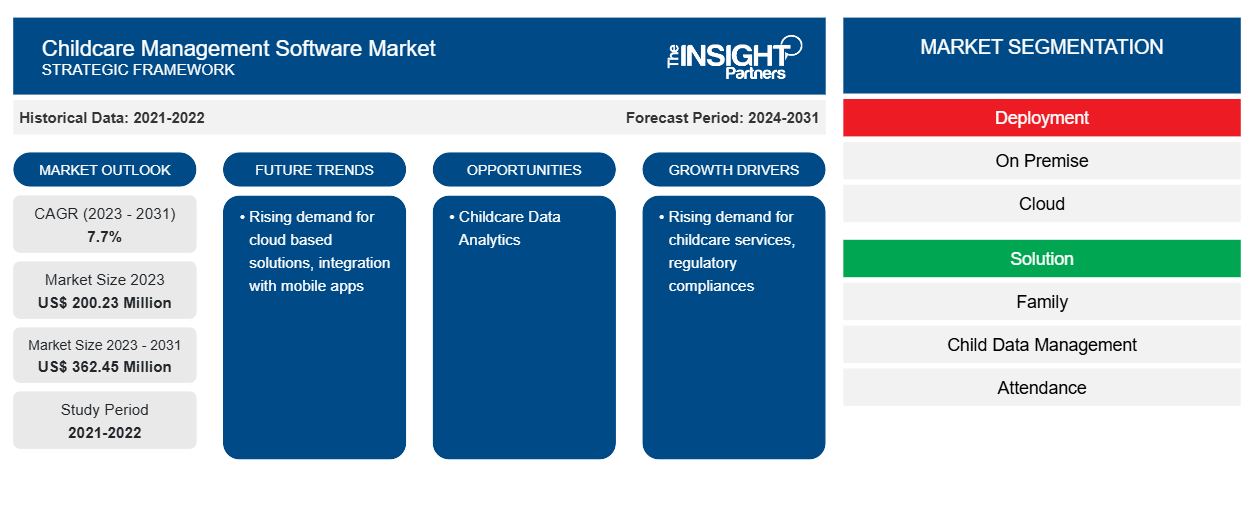Si prevede che la dimensione del mercato del software di gestione dell'assistenza all'infanzia raggiungerà i 362,45 milioni di dollari entro il 2031, rispetto ai 200,23 milioni di dollari del 2023. Si prevede che il mercato registrerà un CAGR del 7,7% nel 2023-2031. La crescente domanda di soluzioni basate su cloud e l'integrazione con app mobili rimarranno probabilmente le principali tendenze del mercato del software di gestione dell'assistenza all'infanzia.CAGR of 7.7% in 2023–2031. Rising demand for cloud-based solutions and integration with mobile apps are likely to remain key Childcare Management Software market trends.
Analisi di mercato del software di gestione dell'assistenza all'infanzia
Il software di gestione dell'assistenza all'infanzia è una forma di software utilizzata per aiutare le organizzazioni di asili nido e di assistenza all'infanzia a gestire le loro attività. Dopo aver aperto un centro prescolare, può essere utilizzato per una varietà di scopi, tra cui il monitoraggio delle presenze, la gestione del denaro e la comunicazione con i genitori. Un'attività di assistenza all'infanzia efficiente e di successo richiede un'organizzazione fluida, una comunicazione efficace e procedure amministrative semplificate, questo sta guidando la domanda di mercato del software di gestione dell'assistenza all'infanzia.
Panoramica del mercato del software di gestione dell'assistenza all'infanzia
La domanda globale di software per la gestione dell'assistenza all'infanzia è guidata principalmente dal crescente numero di genitori nella forza lavoro globale. Ciò genera la necessità di sempre più istituti di assistenza all'infanzia in tutto il mondo, principalmente nelle città metropolitane. Inoltre, la necessità di tracciare in tempo reale le attività dei bambini in questi centri di assistenza all'infanzia sta determinando l'adozione di un software efficiente per la gestione dell'assistenza all'infanzia da parte di questi centri.
Personalizza questo report in base alle tue esigenze
Riceverai la personalizzazione gratuita di qualsiasi report, comprese parti di questo report, o analisi a livello nazionale, pacchetto dati Excel, oltre a usufruire di grandi offerte e sconti per start-up e università
- Scopri le principali tendenze di mercato in questo rapporto.Questo campione GRATUITO includerà analisi di dati che spaziano dalle tendenze di mercato alle stime e alle previsioni.
Driver e opportunità del mercato del software per la gestione dell'assistenza all'infanzia
Conformità normative per favorire il mercato
La conformità è una componente fondamentale per gestire un'attività di asilo nido di successo. Assicura che i bambini di cui ti prendi cura siano al sicuro, sani e felici e che i tuoi dipendenti siano adeguatamente formati, competenti e professionali. La conformità protegge anche la tua azienda da conseguenze legali, sanzioni finanziarie e danni alla reputazione. Tuttavia, la conformità può essere difficile da gestire, in particolare nel dinamico e diversificato settore dell'assistenza all'infanzia. Esistono numerose normative, standard e best practice che devi seguire, che possono variare a seconda della tua posizione, del tipo di servizio e dello stato di accreditamento. Inoltre, la conformità è un processo continuo che richiede monitoraggio, aggiornamento e reporting regolari. I fornitori di servizi di assistenza all'infanzia devono conservare numerosi record per i loro dipendenti, bambini e famiglie, tra cui presenze, salute, vaccinazioni, iscrizione, contatti di emergenza e informazioni di pagamento. Questi record devono essere aggiornati regolarmente e archiviati in modo sicuro per garantire la riservatezza e la riservatezza dei dati. Tuttavia, la gestione manuale di questi record può richiedere molto tempo, essere soggetta a errori e rappresentare uno spreco. Ciò determina la domanda di software di gestione dell'assistenza all'infanzia sul mercato.reputational harm. However, compliance can be difficult to navigate, particularly in the dynamic and diverse childcare industry. There are numerous regulations, standards, and best practices that you must follow, which may differ depending on your location, service type, and accreditation status. Furthermore, compliance is a continuous process that necessitates regular monitoring, updating, and reporting. Childcare providers must preserve numerous records for their employees, children, and families, including attendance, health, immunization, enrollment, emergency contact, and payment information. These records must be updated on a regular basis and securely stored to ensure data privacy and confidentiality. However, manually maintaining these records can be time-consuming, error-prone, and wasteful. This drives the demand for childcare management software in the market.
Analisi dei dati sull'assistenza all'infanzia: un'opportunità nel software di gestione dell'assistenza all'infanzia
I servizi di assistenza all'infanzia hanno un impatto significativo sullo sviluppo della nostra società. Questi servizi, che vanno dall'educazione della prima infanzia alla salvaguardia della sicurezza e del benessere dei bambini, sono fondamentali sia per lo sviluppo generale dei genitori che lavorano sia per quello delle giovani menti. Tuttavia, gestire in modo efficiente gli asili nido non è un compito facile. I fornitori devono affrontare vari ostacoli, come il mantenimento di un'assistenza di alta qualità, l'ottimizzazione dell'allocazione delle risorse e la garanzia della conformità normativa. È qui che l'analisi dei dati entra in gioco come uno strumento prezioso per scoprire approfondimenti e guidare un cambiamento positivo. L'analisi aiuta a determinare il successo delle iniziative educative. L'analisi rivela opportunità di miglioramento, come il mantenimento di una buona pulizia, la prevenzione degli incidenti e la risposta rapida ai problemi di salute.
Analisi della segmentazione del rapporto di mercato del software di gestione dell'assistenza all'infanzia
I segmenti chiave che hanno contribuito alla derivazione dell'analisi di mercato del software per la gestione dell'assistenza all'infanzia sono distribuzione, soluzione e applicazione.
- In base all'implementazione, il mercato del software di gestione dell'assistenza all'infanzia è suddiviso in on-premise e cloud. Il segmento cloud ha detenuto la quota maggiore del mercato nel 2023.
- In base alla soluzione, il mercato dei software per la gestione dell'assistenza all'infanzia è suddiviso in gestione dei dati di famiglia e bambini, presenze, contabilità, gestione del tempo e delle attività, gestione dell'alimentazione e altri.
- In base all'applicazione, il mercato dei software per la gestione dell'assistenza all'infanzia è suddiviso in asili nido, servizi di assistenza prima e dopo la scuola, scuole materne, campeggi e altri.
Analisi della quota di mercato del software di gestione dell'assistenza all'infanzia per area geografica
L'ambito geografico del rapporto di mercato sul software per la gestione dell'assistenza all'infanzia è suddiviso principalmente in cinque regioni: Nord America, Asia Pacifico, Europa, Medio Oriente e Africa e Sud America/Sud e Centro America.
Il Nord America ha dominato ilmercato del software di gestione dell'assistenza all'infanzia. Gli sviluppi tecnologici e le iniziative intraprese dal governo in tutto il Nord America stanno guidando la crescita del mercato. Il mercato del software di gestione dell'assistenza all'infanzia sta subendo uno sviluppo sostanziale in Nord America, che può essere attribuito al significativo aumento dell'occupazione femminile nella regione.
Approfondimenti regionali sul mercato del software per la gestione dell'assistenza all'infanzia
Le tendenze regionali e i fattori che influenzano il mercato del software di gestione dell'assistenza all'infanzia durante il periodo di previsione sono stati ampiamente spiegati dagli analisti di Insight Partners. Questa sezione discute anche i segmenti e la geografia del mercato del software di gestione dell'assistenza all'infanzia in Nord America, Europa, Asia Pacifico, Medio Oriente e Africa e America meridionale e centrale.

- Ottieni i dati specifici regionali per il mercato del software di gestione dell'assistenza all'infanzia
Ambito del rapporto di mercato sul software di gestione dell'assistenza all'infanzia
| Attributo del report | Dettagli |
|---|---|
| Dimensioni del mercato nel 2023 | 200,23 milioni di dollari USA |
| Dimensioni del mercato entro il 2031 | 362,45 milioni di dollari USA |
| CAGR globale (2023-2031) | 7,7% |
| Dati storici | 2021-2022 |
| Periodo di previsione | 2024-2031 |
| Segmenti coperti | Per distribuzione
|
| Regioni e Paesi coperti | America del Nord
|
| Leader di mercato e profili aziendali chiave |
|
Densità dei player del mercato del software di gestione dell'assistenza all'infanzia: comprendere il suo impatto sulle dinamiche aziendali
Il mercato del software di gestione dell'assistenza all'infanzia sta crescendo rapidamente, spinto dalla crescente domanda degli utenti finali dovuta a fattori quali l'evoluzione delle preferenze dei consumatori, i progressi tecnologici e una maggiore consapevolezza dei vantaggi del prodotto. Con l'aumento della domanda, le aziende stanno ampliando le loro offerte, innovando per soddisfare le esigenze dei consumatori e capitalizzando sulle tendenze emergenti, il che alimenta ulteriormente la crescita del mercato.
La densità degli operatori di mercato si riferisce alla distribuzione di aziende o società che operano in un particolare mercato o settore. Indica quanti concorrenti (operatori di mercato) sono presenti in un dato spazio di mercato in relazione alle sue dimensioni o al valore di mercato totale.
Le principali aziende che operano nel mercato del software per la gestione dell'assistenza all'infanzia sono:
- Bloomz, Inc
- Eleonora
- Himalaya
- iclasspro
- Controllo dei bambini
- Centro per l'infanzia
Disclaimer : le aziende elencate sopra non sono classificate secondo un ordine particolare.

- Ottieni una panoramica dei principali attori del mercato dei software di gestione dell'assistenza all'infanzia
Notizie di mercato e sviluppi recenti del software di gestione dell'assistenza all'infanzia
Il mercato del Childcare Management Software viene valutato raccogliendo dati qualitativi e quantitativi post-post-primari e secondari, che includono importanti pubblicazioni aziendali, dati associativi e database. Di seguito è riportato un elenco degli sviluppi nel mercato del Childcare Management Software e delle strategie:
- Brightwheel, la piattaforma leader per l'educazione precoce all-in-one, ha annunciato l'acquisizione di Experience Early Learning, un marchio noto a livello nazionale che sviluppa un curriculum di educazione precoce completo basato sulla ricerca e un sistema di valutazione. L'acquisizione di Bright Wheel riunisce per la prima volta il meglio degli strumenti di apprendimento fisici e digitali, promuovendo il suo obiettivo di fornire un'educazione precoce di alta qualità a tutti i bambini. (Fonte: Brightwheel, comunicato stampa, 2023)
Copertura e risultati del rapporto di mercato sul software di gestione dell'assistenza all'infanzia
Il rapporto "Dimensioni e previsioni del mercato del software di gestione dell'assistenza all'infanzia (2023-2031)" fornisce un'analisi dettagliata del mercato che copre le seguenti aree:
- Dimensioni e previsioni del mercato a livello globale, regionale e nazionale per tutti i segmenti di mercato chiave coperti dall'ambito
- Dinamiche di mercato come fattori trainanti, vincoli e opportunità chiave
- Principali tendenze future
- Analisi dettagliata delle cinque forze PEST/Porter e SWOT
- Analisi di mercato globale e regionale che copre le principali tendenze di mercato, i principali attori, le normative e gli sviluppi recenti del mercato
- Analisi del panorama industriale e della concorrenza che copre la concentrazione del mercato, l'analisi della mappa di calore, i principali attori e gli sviluppi recenti
- Profili aziendali dettagliati
- Analisi storica (2 anni), anno base, previsione (7 anni) con CAGR
- Analisi PEST e SWOT
- Valore/volume delle dimensioni del mercato - Globale, Regionale, Nazionale
- Industria e panorama competitivo
- Set di dati Excel
Report recenti
Rapporti correlati
Testimonianze
Motivo dell'acquisto
- Processo decisionale informato
- Comprensione delle dinamiche di mercato
- Analisi competitiva
- Analisi dei clienti
- Previsioni di mercato
- Mitigazione del rischio
- Pianificazione strategica
- Giustificazione degli investimenti
- Identificazione dei mercati emergenti
- Miglioramento delle strategie di marketing
- Aumento dell'efficienza operativa
- Allineamento alle tendenze normative





















 Ottieni un campione gratuito per - Mercato del software di gestione dell'assistenza all'infanzia
Ottieni un campione gratuito per - Mercato del software di gestione dell'assistenza all'infanzia